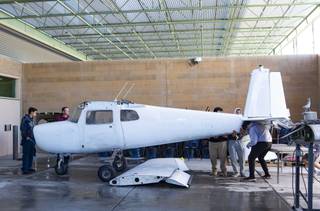
Miranda Alam/Special to the Sun
Students of Rancho High School’s Academy of Aviation move airplane parts around the workspace at Rancho High School in North Las Vegas on Monday, Nov. 18, 2019.
Friday, Dec. 6, 2019 | 2 a.m.
Dillon Cassell has dreamed of becoming a pilot since middle school.
The Rancho High senior comes from a long line of pilots and first responders, including his father, who was killed while serving with the U.S. Air Force. Cassell, 17, is enrolled in Rancho’s Academy of Aviation, the only one of its kind in the state, where students are introduced to pilot training, along with the mechanics of aviation and aeronautical sciences.
“My idea is to go into the Air Force and eventually become a commercial pilot,” Cassell says. “My namesake had a little something to do with it.”
The industry is seeking more aspiring pilots like Cassell, since many in today’s workforce are reaching the federally mandated retirement age of 65. “In the next 15 years, nearly 41,000 major airline pilots will turn 65,” says Louis Smith, president of Future & Active Pilot Advisors, a career and financial resource for professional pilots. “They will need to be replaced by newly hired pilots.”
In 1987, there were about 827,000 pilots in the United States. That number has seen a 30% decrease over the past three decades, according to the Federal Aviation Administration. “Many of the pilots hired by the major airlines are poached from the regional airlines and the military,” Smith says. “This created staffing problems and shortages for both sectors.”
These factors will further exacerbate what many in the industry are calling a pilot shortage during an unprecedented demand for air travel, with the number of airline passengers doubling to 7.8 billion per year by 2036, according to International Air Transport Association.
For Las Vegas-based air carrier Allegiant Air, the pilot shortage hasn’t made much of an impact yet, according to Tracy Tulle, Allegiant’s senior vice president of flight and crew operations. Still, the company is keeping an eye on it as pilot sourcing becomes more and more competitive.
Rancho aviation instructor Gary Archambeault says that while some airlines might not yet be feeling the shortage’s effects, projected numbers should be a concern—and airlines need to be creative in recruiting new pilots.
“We’re not getting as many pilots from the military as before,” he says. “There aren’t as many pilots going into the military, and their commitment is longer than it was many years ago.”
Bolstering new pilots
Tony Truong used to love to go plane spotting with his father—identifying and marveling at different aircraft on the runways of McCarran International Airport.
At Rancho, he continues stoking that passion with classes in both flying and maintaining an aircraft. He’s been working on a Cessna 150, a two-seat tricycle gear general aviation airplane. “We’re redoing the interior and all the flight controls. We also did the landing gear and hydraulics system,” Truong says.
Earlier this year, Allegiant donated thousands of pounds of aircraft parts, including landing gears, an engine thrust reverser, radar antennae and other hydraulic and avionics components in support of the program, according to Allegiant spokeswoman Hilarie Grey. She says it’s one way for the company to help a younger generation join the industry.
Archambeault says the buzz about the aviation industry’s labor shortage is already evident in the enrollment rates for Rancho’s program. “The number of students who are applying for the lottery system to get into Rancho’s aviation program are way up from the past couple of years,” he says.
One of the program’s biggest benefits: getting hours on a flight simulator, a device many beginner pilots use during training. The program digitally re-creates flight environments and replicates equations that govern how aircraft fly.
Those hours count toward obtaining a private pilot’s license—a significant value. Becoming a pilot is expensive, costing between $120,000 to $300,000, Smith says. “The cost is definitely an obstacle in building our nation’s future aviator workforce.” Pilots also require 40 hours of flight training to obtain a private license, and 1,500 hours to fly commercially.
Offsetting the high cost of schooling, however, are increasing salaries, Smith points out. The average salary for an Allegiant pilot is $70,000, with some pulling down six figures, Tulle says.
“Major-airline pilot pay has improved considerably during the past few years, primarily due to growing industry profits and pattern bargaining by the unions,” Smith says. “The most significant increase is at the regional airline level, where first-year pay has increased threefold in the past six years. The pay has grown from an average of approximately $20,000 to $60,000 due to signing and completion bonuses. This was caused by significant attrition of pilots leaving for the major airlines and new regulations requiring higher total flight times to qualify for the scheduled airlines.”
Truong says he will look to continue his pilot training at an aeronautical university. If that doesn’t happen, he says, he’ll look to the maintenance side of aviation, which also has a workforce gap that will need to be filled, aviation officials say.
Over the next two decades, the industry will require an additional 769,000 new maintenance technicians, according to the 2019 Boeing Pilot & Technician Outlook, a commonly referenced industry forecast of personnel demand.
“Everyone in my family is supporting me and they really want me to do something in the field of aviation,” Truong says.
This story appeared in Las Vegas Weekly.

